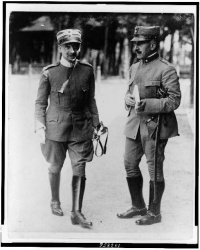Italy at War↑
The secret Treaty of London in April 1915 brought Italy into the Great War. In return for declaring war on the Entente side, Italy was promised Trentino and Tyrol, Istria, central Dalmatia, the Bay of Valona, southwestern Asia Minor and compensation for German African colonies conquered by Great Britain and France. The treaty excluded Fiume (Rijeka). Italian Foreign Minister Sidney Sonnino (1847-1922) wanted the Adriatic port for Hungary or a Croatian state bordering Serbia. Either would contain an enlarged Serbia, buttressing Italian Adriatic supremacy. Russian sources revealed the treaty to the Serbs who were planning a postwar South Slav state (Yugoslavia) incorporating Montenegro, Bosnia, Croatia, Slovenia and northern Albania.
Italy declared war only on Austria-Hungary in May 1915, and on the Ottoman Empire two months later, but only declared war on Germany in August 1916. Except for one division sent to the Balkans, Italy concentrated its forces against the Dual Monarchy. Eleven costly but inconclusive offensives followed until a disastrous result at Caporetto in October 1917. The British and French sent eleven divisions to the Italian Front.
The Italians defeated a final Austro-Hungarian offensive in June 1918. In July, the last German attack in France failed, which were followed by major Allied advances. In September, the Allies advanced from Salonika. Bulgaria soon capitulated. On 3 October, the Germans requested an armistice. In late October, the Serbs reached the Croatian border. While one Italian division entered Albania, sixty-one in Italy remained in place.
On 24 October 1918, first anniversary of Caporetto, a poem by Gabriele D’Annunzio (1863-1938) appeared in Corriere della Sera: “Vittoria nostra, non sarai mutilata” Perhaps the poet’s plaster cast of the Winged Victory of Samothrace inspired the phrase “mutilated victory.” D’Annunzio’s fears arose from Italian stasis, Serb autumn conquests and American and French support for a South Slav state. Yet that same day, the Italians attacked. After brief resistance, the Austro-Hungarians collapsed. The Italians dictated a 4 November armistice granting them occupation of territory promised under the London Treaty and passage through the Brenner Pass. By then, the Turks surrendered. Without allies and facing an invasion of Bavaria, the Germans accepted the 11 November armistice terms.
The Paris Peace Conference↑
Amid jubilation, Prime Minister Vittorio Emanuele Orlando (1860-1952) announced “a Roman victory.” But impending Serb proclamation of a Yugoslav kingdom provoked anxiety. Starting in late November, the Italian high command deployed hundreds of agents to help Slovenes, Croats and Montenegrans resist incorporation into Yugoslavia. In December, President Woodrow Wilson (1856-1924) rejected Italian demands for Fiume. Wilson insisted his Fourteen Points, somewhat amended, would guide the peace settlement. These stipulated frontiers along “lines of nationality,” self-determination for Austro-Hungarian nationalities and Serb access to the Adriatic. The London Treaty placed 230,000 Germans within Italy. Possession of Istria and central Dalmatia would bring 1,100,000 Slovenes and Croats within Italy and restrict Serb sea communications.
The war cost Italy 680,000 lives and imposed enormous debts. Italians expected compensation. Italy’s allies, however, perceived little help defeating the main enemy, Germany. Italian demands seemed excessive. Sonnino’s inflexible diplomacy in Paris aroused resentment. Wilson expected the Brenner frontier would reconcile Italy to losing Fiume. It did not. Italian insistence on London Treaty provisions and the port met Wilson’s unyielding refusal.
In March, the Italians landed in southwest Turkey. In April, they armed Austrians defending Carinthia against Yugoslav invasion. But thwarted over Fiume, Orlando and Sonnino left Paris. That brought no concessions. They returned to discover colonial questions settled; their claims for an Ethiopian protectorate and major extension of Libya rejected. The Italians reacted by equipping Hungarians to battle Czech and Romanian allies of France. In Paris, compromise over Fiume and Dalmatia failed. The Serbs annexed their Slav neighbors and occupied Carinthia. The Orlando government fell in June. The Romanians overran Hungary in August 1919.
After Paris↑
D’Annunzio led the seizure of Fiume in September. That goaded Italy and Yugoslavia to negotiate. They signed the Rapallo Treaty in November 1920. Italy renounced Fiume and Dalmatia, except for Zara (Zadar), four islands and small frontier adjustments. Italy retained 500,000 South Slav inhabitants. In December, Italian forces liberated Fiume, thereafter a free state until 1924.
Meanwhile, insurgency and malaria ended occupation of Albania in September 1920. In June 1921, nationalist victory in Turkey prompted Italian evacuation. Vittoria mutilata seemed appropriate description of Italian failures. That was false. Italian unification was completed, the Dual Monarchy destroyed, Anschluss prohibited by the September 1919 St. Germain Treaty. The Versailles Treaty granted Italy thirty-six million tons of German coal. An October 1920 plebiscite awarded Carinthia to Austria. No unwavering hostile great power bordered Italy. Postwar prostration, nationalist fantasies, imperialist delusions, poor diplomacy obscured Italy’s greatest victory.
Brian R. Sullivan, Independent Scholar
Section Editor: Marco Mondini
Selected Bibliography
- Albrecht-Carrié, René: Italy at the Paris Peace Conference, New York 1938: Columbia University Press.
- Burgwyn, H. James: The legend of the mutilated victory. Italy, the Great War, and the Paris Peace Conference, 1915-1919, Westport 1993: Greenwood Press.
- Haywood, Geoffrey A.: Failure of a dream. Sidney Sonnino and the rise and fall of liberal Italy 1847-1922, Florence 1999: L. S. Olschki.
- Hughes-Hallett, Lucy: Gabriele d'Annunzio. Poet, seducer and preacher of war, New York 2014: Anchor Books.
- Melchionni, Maria Grazia: La vittoria mutilata. Problemi ed incertezze della politica estera italiana sul finire della Grande Guerra (ottobre 1918 - gennaio 1919), Rome 1981: Edizioni di storia e letteratura.
- Ministero degli affari esteri: I documenti diplomatici italiani, 1918-1922. Series 6, 3 volumes, Rome 1955-2007: Libreria dello Stato.









